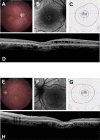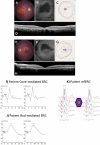Comprehensive analysis of patients with Stargardt macular dystrophy reveals new genotype-phenotype correlations and unexpected diagnostic revisions
- PMID: 25474345
- PMCID: PMC4385427
- DOI: 10.1038/gim.2014.174
Comprehensive analysis of patients with Stargardt macular dystrophy reveals new genotype-phenotype correlations and unexpected diagnostic revisions
Abstract
Purpose: Stargardt macular dystrophy (STGD) results in early central vision loss. We sought to explain the genetic cause of STGD in a cohort of 88 patients from three different cultural backgrounds.
Methods: Next-generation sequencing using a novel capture panel was used to search for disease-causing mutations. Patients with undetermined causes were clinically reexamined and tested for copy-number variations as well as intronic mutations.
Results: We determined the cause of disease in 67% of our patients. Our analysis identified 35 novel ABCA4 alleles. Eleven patients had mutations in genes not previously reported to cause STGD. Finally, 45% of our patients with unsolved causes had single deleterious mutations in ABCA4, a recessive disease gene. No likely pathogenic copy-number variations were identified.
Conclusion: This study expands our knowledge of STGD by identifying dozens of novel alleles that cause the disease. The frequency of single mutations in ABCA4 among STGD patients is higher than that among controls, indicating that these mutations contribute to disease. Disease in 11 patients was explained by mutations outside ABCA4, underlining the need to genotype all retinal disease genes to maximize genetic diagnostic rates. Few ABCA4 mutations were observed in our French Canadian patients. This population may contain an unidentified founder mutation. Our results indicate that copy-number variations are unlikely to be a major cause of STGD.
Figures




References
-
- Kaplan J, Gerber S, Larget-Piet D, et al. A gene for Stargardt's disease (fundus flavimaculatus) maps to the short arm of chromosome 1. Nature genetics. 1993;5(3):308–311. - PubMed
-
- Zhang K, Kniazeva M, Han M, et al. A 5-bp deletion in ELOVL4 is associated with two related forms of autosomal dominant macular dystrophy. Nature genetics. 2001;27(1):89–93. - PubMed
Publication types
MeSH terms
Substances
Grants and funding
LinkOut - more resources
Full Text Sources
Other Literature Sources
Medical
Molecular Biology Databases

